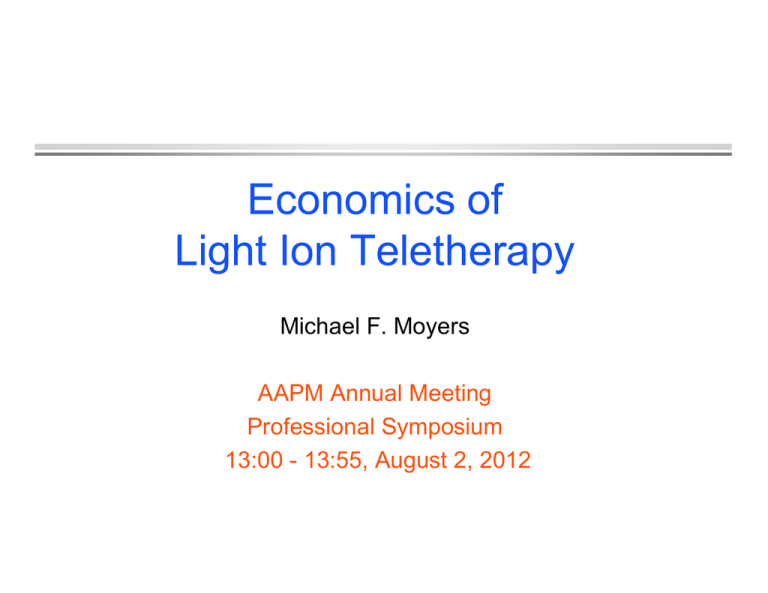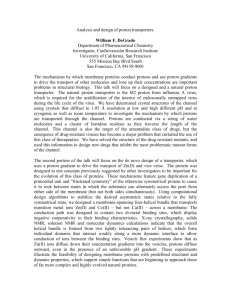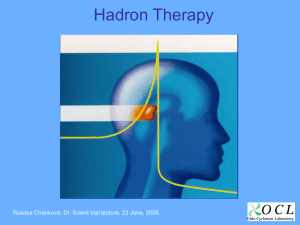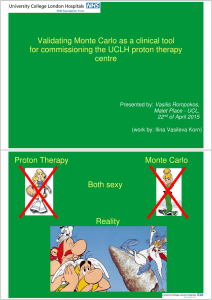Economics of Light Ion Teletherapy Michael F. Moyers AAPM Annual Meeting
advertisement

Economics of Light Ion Teletherapy Michael F. Moyers AAPM Annual Meeting Professional Symposium 13:00 - 13:55, August 2, 2012 Presentation Purpose » assist those considering entry into the field to make informed decisions Audience » novices to light ion teletherapy Outline » introduction to light ion teletherapy and challenges to widespread implementation » example costs and reimbursements for current generation of light ion equipment » example methods of decreasing cost and associated tradeoffs in performance these methods may incur Acknowledgements and References The Modern Technology of Radiation Oncology, v. 3 editor Van Dyk, J. Chapter 10: Radiation therapy with light ions Vatnitsky, S. M. Moyers, M. F. Medical Physics Publishing expected publication spring 2013. Number of Patients Treated with Heavy Charged Particles Worldwide Heavy Charged Particles Pions 1,098 Light Ions 83,896 Other Ions 22 hydrogen-1 73,804 silicon-28 20 helium-4 2,142 argon-40 2 carbon-12 7,151 neon-20 299 2010 totals Light Ion Teletherapy Milestones 1954 1957 1958 1965 1975 1977 1978 1989 1990 1991 1996 1997 1998 2005 Berkeley Uppsala Berkeley Boston Boston Berkeley Chiba Tsukuba Loma Linda Loma Linda Loma Linda Darmstadt Loma Linda Loma Linda first patient treated with protons first patient treated with uniform scanning with protons first patient treated with helium ions first AVM treated with protons first ocular melanoma treated with protons first patients treated with carbon and neon ions first patients treated with modulated scanning protons first proton patients treated with respiratory beam gating first patient treated in hospital with protons first use of rotating gantry first electronic x ray imaging for daily alignment of protons first patients treated with modulated scanning with carbon 100 proton patients treated in one day 173 proton patients treated in one day Rationale for Light Ion Teletherapy 1. The dose delivered to non-target tissues relative to the dose delivered to target tissues is lower than for other radiation beams due to the depth dose distribution. 2. The lateral and distal dose gradients are higher than for other radiation beams enabling better splitting of the target and normal tissues. 3. For ions heavier than helium, a differential RBE with depth results in a higher biological dose in target tissues compared to surrounding normal tissues. Proton vs. IMXT - Chest ratio of integral dose to body outside target = 1.76 ratio of volume of body outside target receiving > 2 Gy = 2.47 Proton vs. IMXT - Prostate ratio of integral dose to body outside target = 1.81 ratio of volume of body outside target receiving > 2 Gy = 2.59 Light Ions vs. Photons - Brain Radiosurgery Phillips et al., 1990 Challenges to Widespread Implementation of Light Ion Teletherapy Question: » If light ions are so much better than other forms of radiation, then why are they not being used? – <1% of patients receiving radiotherapy in the USA receive protons – no patients in the USA receive light ions heavier than protons Possible Answers: » » » » » » initial cost of equipment initial cost of facility (large equipment large shielding) cost of maintenance contracts availability and reliability of equipment inefficient operations lack of trained personnel Example Costs and Reimbursement for the Current Generation of Equipment Many Components to Accelerators Crude Estimates of Component Costs to Customer of Proton Synchrotron [costs in millions of U. S. dollars] Large Complex Gantries [model of Loma Linda gantry] Crude Estimates of Component Costs to Customer of Proton Gantry [costs in millions of U. S. dollars] Cost Sharing of Accelerator Between 4 Treatment Rooms Crude Estimates of Component Costs to Customer of Radiation Distribution System [costs in millions of U. S. dollars] Proton Initial Costs and Financing [costs in millions of U. S. dollars] Initial Costs Loan? Reimbursement Rate for Single Fraction Moyers and Vatnitsky, 2012 Hypothetical Payor Mix Moyers and Vatnitsky, 2012 Reimbursement Rate for Simple Proton [based upon 2009 USA Medicare payments x 1.39 to represent typical payor mix] Moyers and Vatnitsky, 2012 Reimbursement Rate for Complex Proton [based upon 2009 USA Medicare payments x 1.39 to represent typical payor mix] Moyers and Vatnitsky, 2012 Patient Throughput for 4 Room Facility Moyers and Vatnitsky, 2012 Annual Reimbursement [based upon 2009 USA Medicare payments x 1.39 to represent typical payor mix] Moyers and Vatnitsky, 2012 Proton - Total Cost Versus Lifetime Reimbursement [assumes 25 year lifetime] Proton/Helium/Carbon - Total Cost Versus Lifetime Reimbursement [assumes 25 year lifetime] Methods of Reducing Costs and Performance Tradeoffs example treatment methods example equipment methods Rectal Balloons In-house versus Commercial Apertures Lipowitz Metal versus Brass Boluses Wax versus PMMA Milling time for machinable wax is about half that of PMMA. Machinable wax is recyclable on site versus PMMA which is single use. Modulated Scanning Beams Without Apertures and Boluses no devices reduces charges billed to patient ($1,800 / pat) no device installation time but slightly longer beam delivery times (differential cost per patient currently indeterminate) larger lateral penumbra, less conformal to distal surface of target, and less conformal avoidance to distal critical structures » shaping done upstream in radiation head instead of close to patient » digitization of lateral scanning pattern » digitization of energy stacking pattern modulated scanning requires much more beam time for patient specific QA activities potentially reducing number of patients treated per day increasing facility cost per patient. Hypofractionation Examples [2009 reimbursement] low exit dose and less entrance dose (not surface dose) compared to x rays reduces normal tissue effects allowing hypofractionated treatment course prostate » 80 Gy in 40 fractions $38,777 » 60 Gy in 20 fractions $21,171 partial breast » 40 Gy in 10 fractions $12,922 lung nodule » 70 Gy in 10 fractions $12,922 Mass Production of Equipment requirements for "assembly line" » proven continuous customer (healthcare facility) demand » stable design » continuous supply of parts requirements for customer demand » » » » healthcare professionals believe light ions are better treatment patients believe light ions are better treatment payors believe light ions are an acceptable treatment payors (patient, insurance company, government agency) reimburse facilities for light ions at rates such that the facilities can break even Equipment Size reduced equipment size reduced facility costs » land, construction, electricity costs » workflow efficiencies folded structures » accelerators, gantries reduced range of available gantry angles superconducting magnets reduced maximum available energy » 300 MeV (50 cm range) allows proton CT and radiography » 250 MeV (37 cm range) allows treatment through long bones and metal implants and use of contralateral approaches to avoid critical structures or previously treated tissues » 220 MeV (30 cm range) allows treatment of 90% of patients Comparison of Accelerator Layouts Comparison of Gantry Layouts Energy / Range Accuracy and Levels energy / range interlock » increased costs for instrumentation to monitor and control energy (@ accelerator, switchyard, gantry) » 4 mm enables reduction of integral dose relative to x rays » 0.5 mm enables patch portals » 0.1 to 0.25 mm enables energy stacking » decreased costs for QA effort number of user selectable energies » » » » more energies can increase the cost for commissioning and QA time 18,000 enables conformal energy stacking 256 enables energy stacking but slightly less conformal 8 reduces lateral penumbra but eliminates possibility of energy stacking » 1 requires larger margins for blocking of distal critical structures (large distal penumbra at lower energies) Field Size equipment to support larger field sizes (MLCs, applicators, scanning magnets) generally costs more than equipment that supports only small field sizes due to reduced drift length, diameter of gantry may be reduced if maximum available field length is reduced splitting a large field into multiple small matching fields takes longer to treat and has the potential for poor dose distributions at junctions due to patient movement, divergence, and more possibilities for errors Temporal-Spatial Dose Delivery different instantaneous dose rates have different biological effects on tissues instantaneous dose rate dependencies » beam flux, pulse repetition rate, pulse length, spot size, spot overlap, number of aiming points, scanning speed a longer treatment time reduces the number of patients treated per day increasing the cost per patient reducing the number of aiming points or the overlap between spot paths may reduce the treatment time but may also induce dose non-uniformities within the target. the interactions between various beam delivery parameters should be carefully scrutinized before selecting a beam delivery system Room-to-Room Beam Switching Time longer switching time increases probability of patient moving from aligned position while waiting for beam longer switching time reduces number of patients treated per day increasing cost per patient time to switch beam between rooms for the current generation of equipment varies from a low of 20 s to a high of 240 s lower beam switching time may be optional cost beam switching time can be impacted by integration of various systems; e.g. treatment information and management system Availability and Reliability Loma Linda accelerator has been available 24 h per day, 6.5 days per week, 52 weeks per year for the past 21 years (except for holidays) » treatments 16 h per day » patient and periodic quality assurance 3 - 6 h per night and 12 to 24 h on weekends » research and development 2 h per night and 12 h on weekends » preventative maintenance on one gantry per night for 2 h » preventative maintenance on accelerator and SY on weekends for 12 h » did not repair ring magnets or RFQ over 21 years TIME ALLOTTED FOR MAINTENANCE IN THE SERVICE CONTRACT HAS HUGE IMPACT ON FACILITY REVENUE typical maintenance contract cost may be up to 7% of initial equipment cost each year Future Single Room Solutions smaller patient load easier to justify for smaller facilities smaller initial cost, easier to get loan treatment cost per patient might be higher or lower than with existing equipment, currently unknown » no cost sharing of accelerator between multiple rooms » more expensive materials used to reduce size » newly introduced technology may require more maintenance shorter travel distance for some patients due to more widespread availability reduces cost to patient possibly larger energy spread and possible lack of energy interlock capability may impact ability to perform distal blocking, patch portals, or energy stacking Future LIVMAT and ICT 1st stage DWA ion source and RFQ 2nd stage DWA energy slit 370o rotating gantry structure beam scanning and monitoring system Recapitulation light ion teletherapy has been used for patient treatments since 1954 leading cost in treating with light ions is salaries, next leading costs are supplies and maintenance the cost of the beam delivery equipment has little impact on the cost of treatment but a large impact on the financing of a new facility users should implement methods to increase efficiency of treatments and reduce costs manufacturers should increase reliability to reduce maintenance costs and increase beam time available for patients and QA procedures main impediment to wide-spread implementation is financing for initial cost of equipment and building further research is needed to reduce size and cost of equipment initial costs can be decreased by reducing specified capabilities but beware of the associated loss of performance Learning Objectives I. Become familiar with estimated costs associated with starting and operating a light ion teletherapy facility. II. Become familiar with the relative costs of various items important for the success of a project. III. Become familiar with tradeoffs in performance for various cost saving methods.




